Didn't they make an anti vibration hammer/ axe handle a while ago?Has there been any development or improvement at all in hand tools or their accessories, since, say, 1944
You are using an out of date browser. It may not display this or other websites correctly.
You should upgrade or use an alternative browser.
You should upgrade or use an alternative browser.
Improved hand tool myth.
- Thread starter Jacob
- Start date

Help Support UKworkshop.co.uk:
This site may earn a commission from merchant affiliate
links, including eBay, Amazon, and others.
- Status
- Not open for further replies.
johnnyb
Established Member
a laser level is a game changers with regard to plumb and level. I'm not convinced that things have improved re handtools. a norris was as good maybe better than a lie nielsen.
screws are a huge improvement.
tape measures are better than folding rules. I love the new aluminum clamps over the cast iron ones.
I think accuracy of squares is much improved.
hand tools for making sash windows are now almost non existant but they were very common.
screws are a huge improvement.
tape measures are better than folding rules. I love the new aluminum clamps over the cast iron ones.
I think accuracy of squares is much improved.
hand tools for making sash windows are now almost non existant but they were very common.
Jacob
New Luddism. Awake and resist!
They did and I bought one after I wrecked my wrist on a window job (chipping out hard mortar). Stanley something or other.Didn't they make an anti vibration hammer/ axe handle a while ago?
Also bought a Bosch SDS drill which is brilliant.
Sgian Dubh
Established Member
Ah, Pete, the trick is to not engage. I do like reading Jacob's schtick as he engages with those daft enough to fall for his provocations.I think it is a thread to create argument and not add knowledge. Any tool you like and suggest will just be a launching platform for the "just do it my old way" argument that is at the heart of all his posts. Try to disagree and get pounded and worn down with the same repetitive replies. Can't teach an old dog new tricks.
Pete
The most improved aid to workshop efficiency, not strictly hand tool focused really, has to be the extended long stop, as opposed to the standard long stop that apprentices used to be sent out of the workshop for. Efficiency for the rest of the workshop team improves dramatically with the apprentice out searching (extendedly) for the long stop. Slainte.
Last edited:
bourbon
Established Member
Dogfish skins. used way before sand paper
I'm sorry but the romantic notion of people achieving much more, in less time with less tools is just too tempting a carrot not to chase. I work with an old mason who served his time in a period where a clay soil pipe took a day to boss into, having to fill the pipe with sand and skillfully and very slowly tap a hole. accessed via a pick and shovel and signed off by the town foreman when he turned up. Now I'm not here to say that the working strength and stamina are not admirable but productivity is something else entirely.
hammers are vastly improved if you care to pay the price tag. Tool storage is improved greatly.
I for one would throw automatic wire strippers into the mix, Jacob has merely tricked us all into coming to this subject with the viewpoint of carpentry! Paint rollers were patented in 1940 so i guess they don't count
hammers are vastly improved if you care to pay the price tag. Tool storage is improved greatly.
I for one would throw automatic wire strippers into the mix, Jacob has merely tricked us all into coming to this subject with the viewpoint of carpentry! Paint rollers were patented in 1940 so i guess they don't count
I grew up on building sites in the 60’s. Back then it was pretty much all human powered from digging the footings to loading out the tiles on the roof.
In woodworking yes the wheel gauge is a great improvement
In woodworking yes the wheel gauge is a great improvement
I love power tools because you can do a task much faster and if you mess up it is easy to do again until correct, but I can mess things up much faster with a hand chiesel because it turns me from a woodworker to a butcher which is not good considerng I am a vegetarian !
Terry - Somerset
Established Member
Why would a tool manufacturer apply any effort into developing hand tools which for 80%+ of users had been superseded by power. It is no surprise that most developments are now confined to the top of the hobby market where price and aesthetics often prevail.
Those items to which improvements have been made either have no power alternative or are still in widespread use - eg: hammers, retractable tapes, abrasives, glues, squares etc.
The perceived quality of older traditional tools - planes, chisels, saws, etc - may have some foundation in reality. The reaction of manufacturers seeing a fall in sales volumes in the 1960-1980s would have been to reduce costs to reduce prices to keep demand up. Quality then fell.
Those items to which improvements have been made either have no power alternative or are still in widespread use - eg: hammers, retractable tapes, abrasives, glues, squares etc.
The perceived quality of older traditional tools - planes, chisels, saws, etc - may have some foundation in reality. The reaction of manufacturers seeing a fall in sales volumes in the 1960-1980s would have been to reduce costs to reduce prices to keep demand up. Quality then fell.
Molynoox
Established Member
This comment intrigued me... Are you saying that a current day carpenter using power tools is slower than one from the past using hand tools?In the past, more was achieved in far less a time with far fewer
'tools' than we have available today.
Therein lies a very pertinent question.
If so then that's incredibly interesting and I would like to learn more
thetyreman
Established Member
cuttlefish bone works as wellDogfish skins. used way before sand paper
Molynoox
Established Member
And cats tounguescuttlefish bone works as well
ajs
Established Member
Segmented snap off knives, apparently they date to the 50s.
I don't think the comparative sparsity of truly new classes of hand tool means the sector is some kind of innovation wasteland, it's simply a reflection of a mature sector with few new problems to solve. It follows that innovations are either incremental or predicated on other changes, e.g. to economics or manufacturing processes. The snap off knife is an example of that, it's existence depends on disposable blades being an economically attractive proposition.
Other sectors have seen hand tool development, notably electrical and electronic work. Two hand tools that come to mind straight away are wire wrap and punch down tools, both methods of making high density, semipermanent electrical connections.
What all three have in common is that the introduction was bought about by external factors, i.e. what's changed? Going for woodwork only and hand tools only limits the degrees of freedom for that change to come from, so you will see little truly new ideas.
I don't think the comparative sparsity of truly new classes of hand tool means the sector is some kind of innovation wasteland, it's simply a reflection of a mature sector with few new problems to solve. It follows that innovations are either incremental or predicated on other changes, e.g. to economics or manufacturing processes. The snap off knife is an example of that, it's existence depends on disposable blades being an economically attractive proposition.
Other sectors have seen hand tool development, notably electrical and electronic work. Two hand tools that come to mind straight away are wire wrap and punch down tools, both methods of making high density, semipermanent electrical connections.
What all three have in common is that the introduction was bought about by external factors, i.e. what's changed? Going for woodwork only and hand tools only limits the degrees of freedom for that change to come from, so you will see little truly new ideas.
I quess your answer didn't warrant a rebuttal. But I think you hit the old nail on the head with an old hammer! Well done using old tools!I think it is a thread to create argument and not add knowledge. Any tool you like and suggest will just be a launching platform for the "just do it my old way" argument that is at the heart of all his posts. Try to disagree and get pounded and worn down with the same repetitive replies. Can't teach an old dog new tricks.
Pete
Orraloon
Established Member
Them were the days! After a hard day sanding it was off for fish & chips.Dogfish skins. used way before sand paper
If its that good why do budgies like sandpaper in the floor of the cage.cuttlefish bone works as well
Thats rough! I cant answer this oneAnd cats toungues
Regards
John
Ttrees
Iroko loco!
Lightbulbs have came a long way, the angle poise lamp being a hand tool to me.


Derek Cohen (Perth Oz)
Established Member
As much as I enjoy hand tools, chopping mortices into Jarrah is not one of the fun times. I now prefer a router, but more recently I have come to recognise the value of a Domino ... although not the way that Festool intended the machine to be used 
Anyway, recently I built two beds, which I have just got back to. Having completed them, I discovered that they were 40mm too long and too wide! Duh ... after many measurement checks!
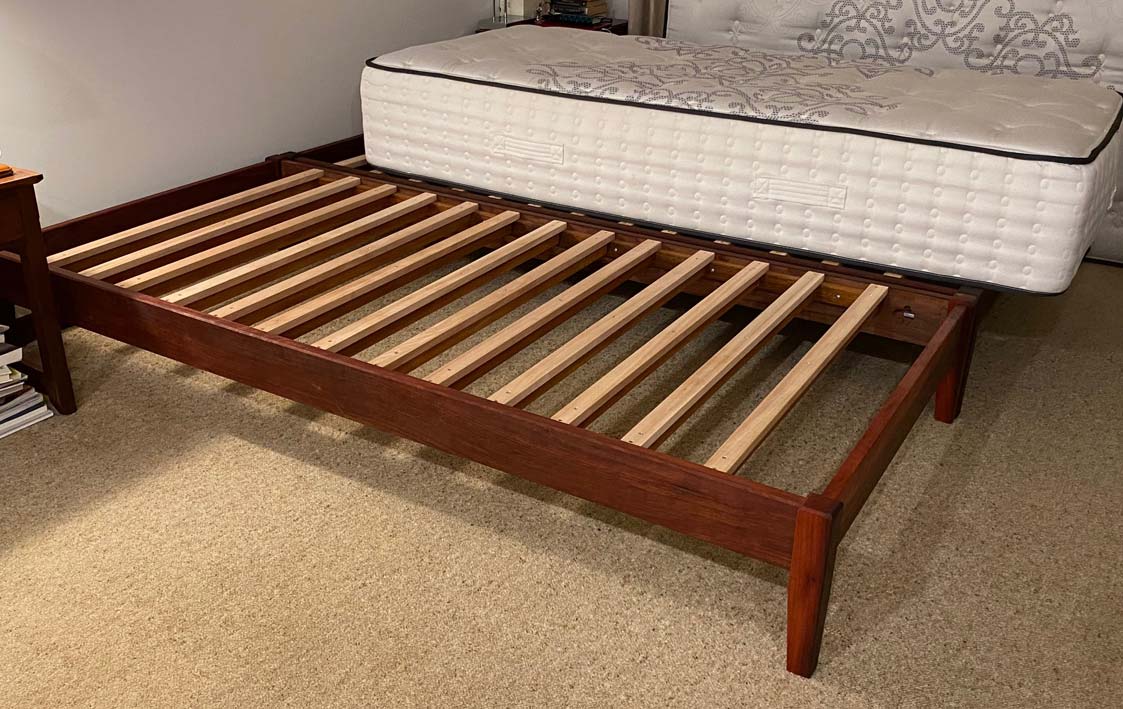
Obviously this meant pulling them apart and shortening the lengths and widths. I started yesterday.
The head-and foot board leg joinery is loose mortice-and-tenon. 110mm long x 10mm wide. This was made fairly easy with a Domino machine. The loose tenons were sized on a jointer/thickness-planer, and then rounded over on a router table. All wood is Jarrah. The aim was for an exact fit.
I am really appreciating the extra bench top space afforded by the new MFT table (yes, the Veritas hold down, although it is sized for a 19mm dog hole works very well on a 20mm dog hole) ...
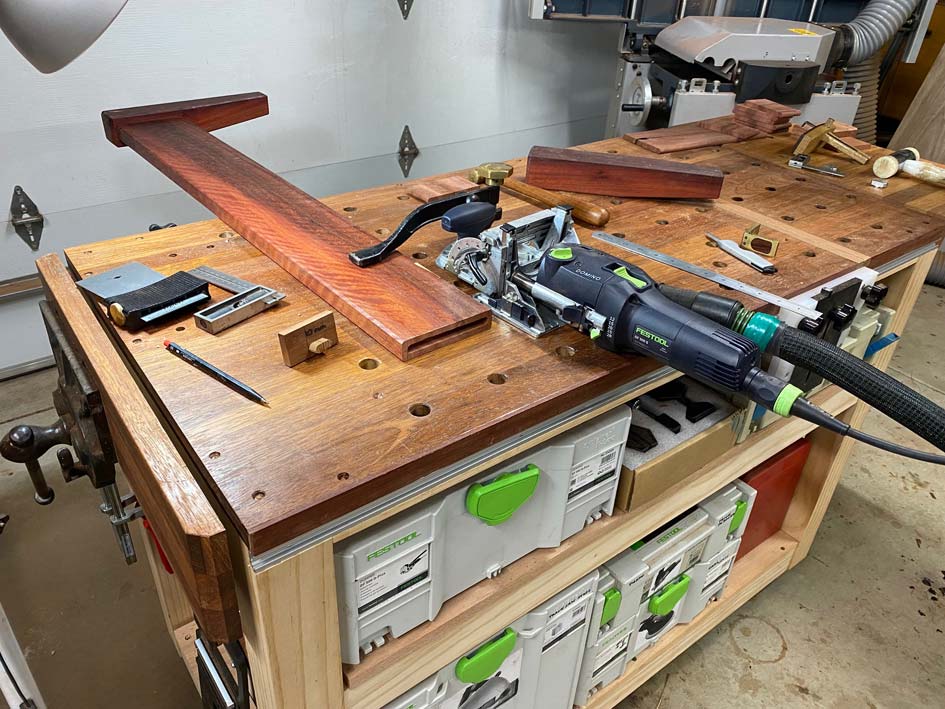
I made a small positioner to mark the centre of the domino, and plunged for the outer ends ...
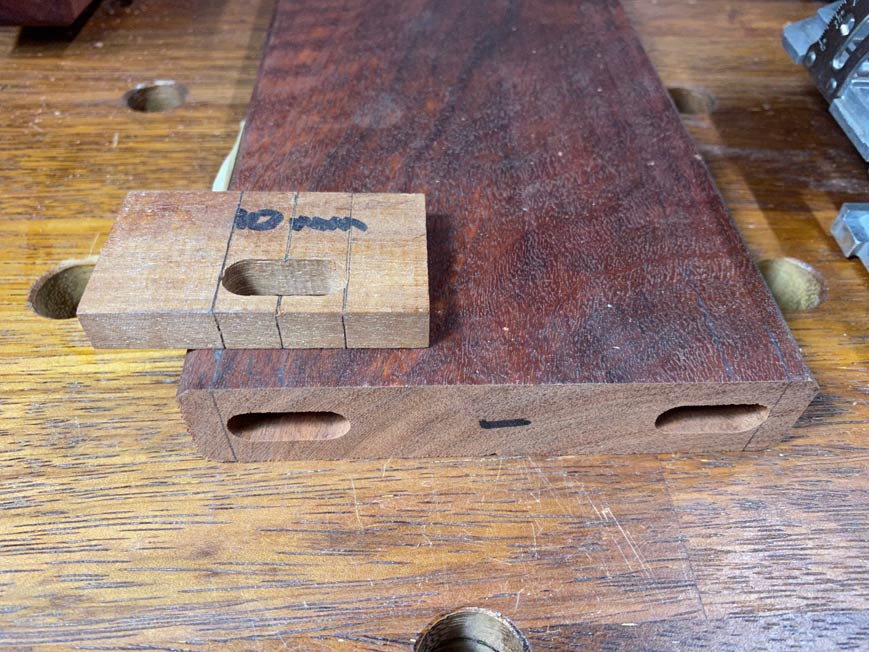
Then complete the mortice by nibbling away the centre section ..
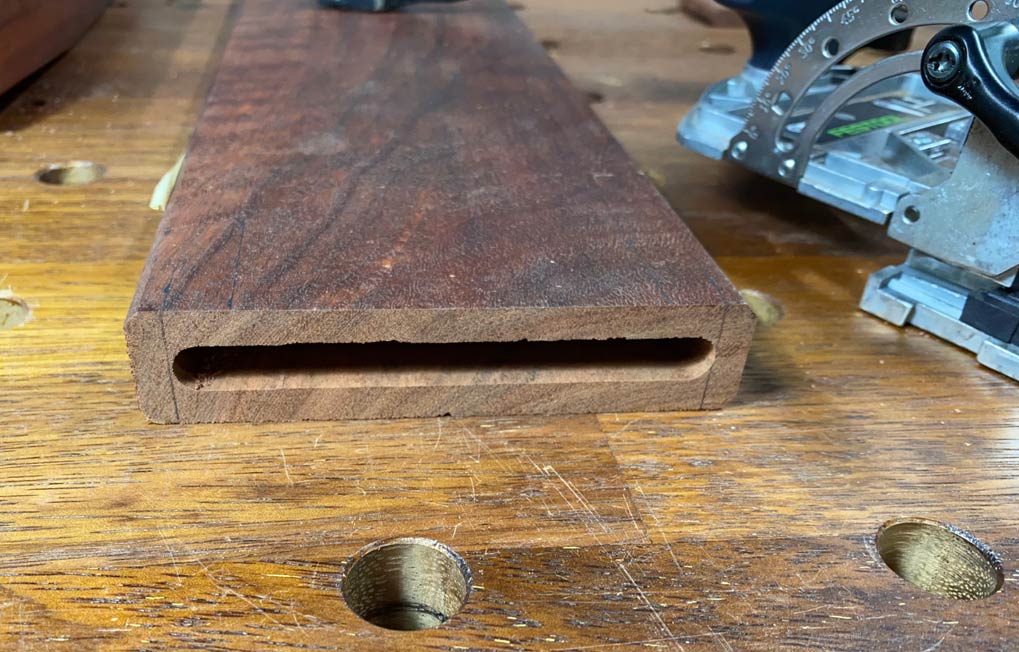
Tight fit in the rail ..
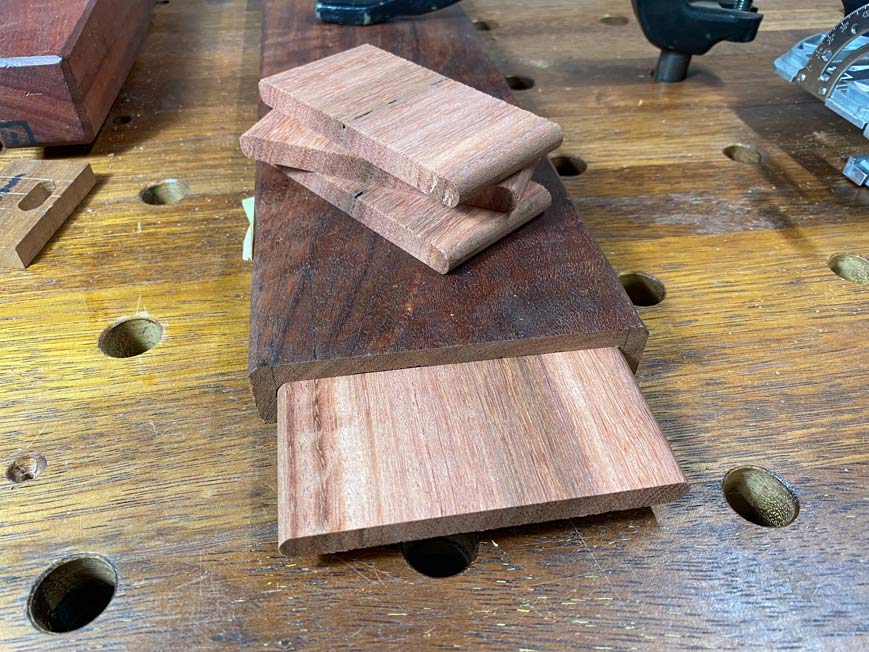
Tight fit in the post ..

This was taken during the build, and how the legs are once again ...
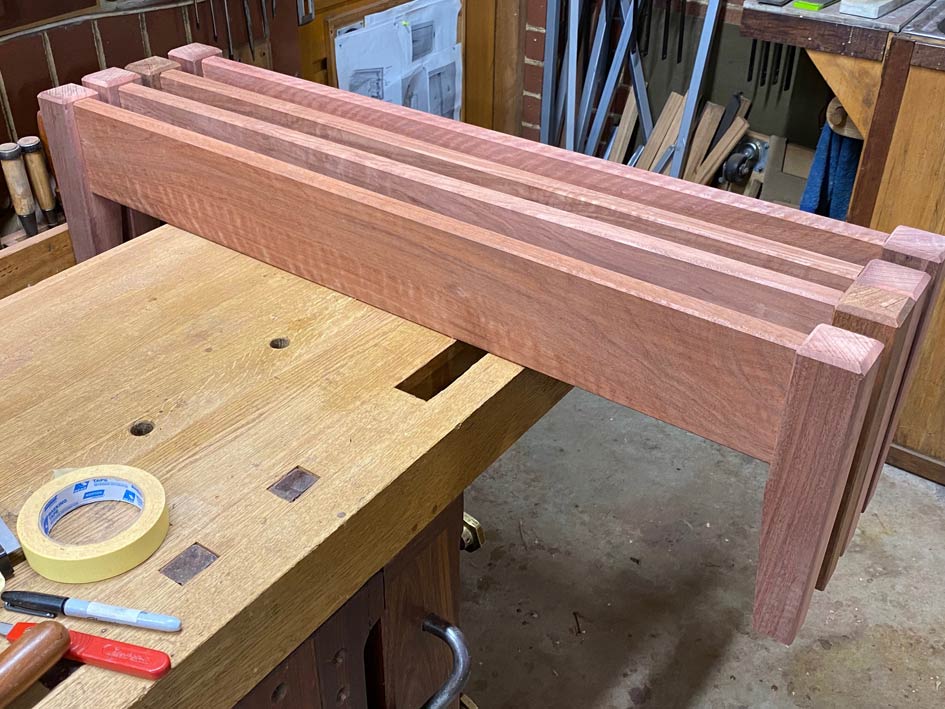
Regards from Perth
Derek
Anyway, recently I built two beds, which I have just got back to. Having completed them, I discovered that they were 40mm too long and too wide! Duh ... after many measurement checks!

Obviously this meant pulling them apart and shortening the lengths and widths. I started yesterday.
The head-and foot board leg joinery is loose mortice-and-tenon. 110mm long x 10mm wide. This was made fairly easy with a Domino machine. The loose tenons were sized on a jointer/thickness-planer, and then rounded over on a router table. All wood is Jarrah. The aim was for an exact fit.
I am really appreciating the extra bench top space afforded by the new MFT table (yes, the Veritas hold down, although it is sized for a 19mm dog hole works very well on a 20mm dog hole) ...

I made a small positioner to mark the centre of the domino, and plunged for the outer ends ...

Then complete the mortice by nibbling away the centre section ..

Tight fit in the rail ..

Tight fit in the post ..

This was taken during the build, and how the legs are once again ...

Regards from Perth
Derek
mark w
Established Member
If you put a new Stanley plane next to a new Lie Nielsen or Veritas plane, I think you'd see vast improvements, better engineering and superior ductile steel in their construction, the blades or irons are massively improved, again superior steels are used and they are more accurately manufactured.
I also think there has been a massive improvement in bevel edge chisels, led by Lie Nielsen and Veritas but taken a step further by Blue Spruce with their concave edges. All of these are better manufactured and use superior steel, if I compare my Blue Spruce chisel to my old Marples chisel the difference is quite stark.
I also think there has been a massive improvement in bevel edge chisels, led by Lie Nielsen and Veritas but taken a step further by Blue Spruce with their concave edges. All of these are better manufactured and use superior steel, if I compare my Blue Spruce chisel to my old Marples chisel the difference is quite stark.
Jameshow
Established Member
But an old plane bitd would have been a much closer match as the company took pride in thier work.If you put a new Stanley plane next to a new Lie Nielsen or Veritas plane, I think you'd see vast improvements, better engineering and superior ductile steel in their construction, the blades or irons are massively improved, again superior steels are used and they are more accurately manufactured.
I also think there has been a massive improvement in bevel edge chisels, led by Lie Nielsen and Veritas but taken a step further by Blue Spruce with their concave edges. All of these are better manufactured and use superior steel, if I compare my Blue Spruce chisel to my old Marples chisel the difference is quite stark.
I think hand tools probably haven't advanced much due to power tools. Much like piston engines planes Vs jet ones.
- Status
- Not open for further replies.
Similar threads
- Replies
- 62
- Views
- 77K
- Replies
- 24
- Views
- 12K



